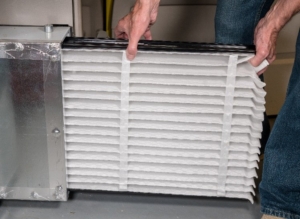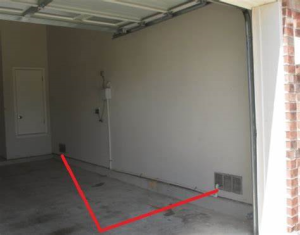Air Conditioner In the Garage Is Okay
Installing an air conditioner in your garage can be a great way to keep the space cool and comfortable, especially during the hot summer months. We see systems in our area of South Florida installed in garages all the time. In most cases it’s a split system used to cool the space but it isn’t the best option for every home. Let’s dive into this some more.
First, you’ll need to determine the size of the air conditioner that you need. The size of the unit will depend on the size of your garage, as well as the level of insulation in the space.
You’ll want to choose a unit that is appropriately sized for your garage, as a unit that is too small will not be able to effectively cool the space, while a unit that is too large will waste energy and money.
Next, you’ll need to decide on the type of air conditioner that you want to install. There are several types to choose from, including window units, portable units, and split-system units.
Window units are the most common type of air conditioner and are relatively easy to install, but they can be noisy and may not be suitable for all garage configurations.
Portable units are also relatively easy to install but can be heavy and bulky and may not be as energy efficient as other options. Split-system units are more expensive and require professional installation, but they are more energy efficient and can be controlled remotely.
There are several different types of air conditioning systems that can be installed in residential properties, each with its own unique set of benefits and drawbacks. Some of the most common types of air conditioning systems include:
- Window air conditioners: These are the most common type of air conditioner and are typically the most affordable option. They are easy to install and can be placed in a window or through a wall. They work by using a refrigerant to cool the air inside the room and then venting the hot air outside. However, window units can be noisy and may not be suitable for all types of buildings, they are also not very energy efficient and may not cool large spaces.
- Split-system air conditioners: This type of air conditioner is composed of two units, an outdoor unit and an indoor unit. They use a refrigerant to cool the air and then circulate it through ductwork to cool the entire house. They are more efficient than window units and can cool larger spaces. They also have better temperature control and can be controlled remotely. However, they are more expensive to install and require professional installation.
- Packaged air conditioners: These systems are self-contained and typically used for larger residential properties and small commercial properties. The condenser, evaporator and compressor are all housed in one unit and are installed outside the building. They are similar to split-systems but don’t require ductwork. They can be a good solution for buildings that can’t accommodate ductwork.
- Ductless mini-split air conditioners: This type of air conditioner is composed of an outdoor unit and one or more indoor units. They use a refrigerant to cool the air and then circulate it through a small duct to cool the room. They are similar to split-systems but do not require ductwork, making them ideal for buildings that can’t accommodate it. They are more expensive than window units but they are more energy efficient and can be controlled remotely.
- Portable air conditioners: These are similar to window units but they are designed to be portable. They have wheels and can be moved from room to room. They are easy to install but can be heavy and bulky. They are not very energy efficient, and may not cool large spaces, but they can be a good option for small spaces.
How to Vent A Portable Air Conditioner In Garage
Venting a portable air conditioner in a garage can be a bit tricky, as you will need to properly seal and vent the hot air that the unit generates. Here are the steps you can take to vent a portable air conditioner in your garage:
- Install the exhaust hose: The first step is to connect the exhaust hose to the back of the portable air conditioner unit. This hose is used to vent the hot air generated by the unit outside of the garage.
- Locate an appropriate venting location: The next step is to locate an appropriate venting location for the exhaust hose. This could be a window, wall, or roof vent. It’s important that the location is close to the unit, and that the hose will not be blocked or kinked.
- Cut the venting hole: Once you have located an appropriate venting location, cut a hole that is slightly larger than the diameter of the exhaust hose.
- Install the vent: Install the vent in the hole and seal around the edges to prevent air leaks.
- Connect the hose to the vent: Once the vent is in place, connect the hose to it and secure it with the clamps that came with the unit.
- Test the unit: Turn on the portable air conditioner and make sure that the hot air is venting properly through the exhaust hose. Check for any leaks or blockages in the hose.
- Proper insulation: If your garage isn’t insulated and it’s not possible to vent the air through a window or wall, you may need to install insulation to help keep the space cool. Proper insulation will help to keep the garage cool and will also help to reduce the amount of hot air that needs to be vented.
It’s important to make sure that the venting location that you choose is properly venting the hot air out of the garage to prevent the buildup of hot air, condensation, mold, or any other issues. Also, be mindful that some areas or buildings may have restrictions or codes regarding how to vent portable AC units, be sure to check your local regulations.
Ultimately, the type of air conditioning system that’s best for your home will depend on a variety of factors, including the size of your home, your budget, and your specific cooling needs. It is recommended consulting with HVAC professional to evaluate what type of system will be the most appropriate and energy efficient for your property.
Cost to Install AC In Garage
The cost of installing an air conditioner in your garage can vary greatly depending on a number of factors such as the type of unit you choose, the size of your garage, and the level of insulation in the space. Generally, window units tend to be the most affordable option and can cost anywhere from $150 to $500.
Portable units can also be relatively affordable, with prices ranging from $300 to $800. The best portable ac for garage will depend on several factors, including the size of the space, the level of insulation, and your specific cooling needs. However, some things to consider when selecting a portable air conditioner for a garage include:
- Cooling capacity: It is essential to choose a unit that has the appropriate cooling capacity for your garage. A unit that is too small will not be able to effectively cool the space, while a unit that is too large will waste energy and money.
- Noise level: Portable air conditioners can be quite loud, so it’s important to choose a unit that has a low noise level. Look for units with noise ratings of around 60 decibels or less.
- Energy efficiency: Portable air conditioners can be less energy efficient than other types of units, so it’s important to choose a unit that has a high energy efficiency rating (EER). Look for units with an EER of at least 10 or higher.
- Features: Some portable air conditioners have additional features such as programmable thermostats, dehumidifiers, and remote controls which can be beneficial.
- Mobility: A unit with wheels can be more useful and easily move from room to room.
Some popular portable air conditioners
Whynter ARC-122DS Elite, the hOmeLabs 14,000 BTU Portable Air Conditioner, and the LG LP1419IVSM. These units have high cooling capacities, low noise levels, high energy efficiency ratings, and additional features such as programmable thermostats and dehumidifiers. It’s important to check the unit’s specification and your garage size before purchasing.
Note that portable ac are not the best option for large spaces, they tend to be less energy efficient and may not cool large spaces as effectively as other types of units. A better option for larger garages may be a window or a split-system unit, or even a packaged unit.
The Best Air Conditioner for garage with No Windows
Split-system units are typically more expensive, and the cost of installation can range from $2,500 to $7,500 depending on the size of the unit, the complexity of the installation, and the location of the garage.
The cost of a packaged unit will also depend on the size and complexity of the installation. A ductless mini-split systems will usually fall within the price range of a split system installation.It’s always a good idea to get a quote from a professional HVAC technician in your area as the cost will vary depending on your local market and cost of labor.
Once you have chosen the type of air conditioner that you want to install, you’ll need to prepare the space for the installation. This may involve removing any existing insulation, sealing any cracks or gaps in the walls or ceiling, and ensuring that there is proper ventilation in the space.
The next step is the actual installation of the unit. This will depend on the type of unit that you have chosen, but generally, you’ll need to follow the manufacturer’s instructions and use the necessary tools and equipment to properly install the unit. For example, if you’re installing a window unit, you’ll need to mount the unit securely in the window and ensure that it is properly sealed to prevent leaks.
If you’re installing a portable unit, you’ll need to place the unit in an appropriate location in the garage and ensure that it is level. If you’re installing a split-system unit, you’ll need to have it installed by a professional HVAC technician, as it will require more advanced installation.
It’s important to do the installation following the manufacturer’s instructions and to also check local building codes and permits as there may be restrictions or regulations on the types of air conditioning units that can be installed in garages in your area.
Once the air conditioner is installed, it’s important to test it to make sure that it’s working properly. This may involve checking for leaks, ensuring that the unit is properly sealed, and testing the thermostat to make sure that it’s controlling the temperature correctly.
How to insulate a garage for air conditioning
Insulating a garage door can help to keep the cool air inside the garage and prevent drafts from entering. Here are the steps you can take to insulate your garage door:
- Measure the garage door: Measure the height, width, and depth of the garage door to determine how much insulation you will need.
- Choose the type of insulation: There are several types of insulation to choose from, including reflective insulation, foam board insulation, and insulation kits specifically designed for garage doors. Reflective insulation typically comes in rolls and can be cut to size, while foam board insulation comes in panels and is lightweight and easy to install. Insulation kits come with everything you need to insulate your garage door, including insulation panels and adhesives.
- Clean the garage door: Clean the garage door thoroughly to ensure that the insulation will adhere properly.
- Install the insulation: Begin installing the insulation on the back of the garage door. The insulation should be cut to fit and should cover the entire back of the door, including the edges.
- Install weather stripping: Install weather stripping around the edges of the garage door to seal any gaps between the door and the frame. This will help to prevent drafts from entering the garage.
- Test the door: Once the insulation is installed, test the garage door to make sure that it still operates properly. Adjust the opener if necessary.
- Add the reflector: If you decide to use reflective insulation, you can add a reflector to the garage door. Reflective insulation comes in rolls and can be cut to size, be sure to follow the manufacturer instructions to properly install it
Insulating a garage door can help to improve the energy efficiency of the space and can help to reduce energy costs. It’s important to choose the right type of insulation and to install it correctly to ensure that it is effective. Be mindful of the insulation r-value of the product you are purchasing, the higher the R-value, the better the insulation performance will be.
Finally, after the installation is complete, you should schedule regular maintenance and check-ups to make sure your unit runs efficiently, This can prolong its life and improve its performance, prolonging the period between replacements.
In conclusion, installing an air conditioner in your garage can be a great way to keep the space cool and comfortable, especially during the hot summer months. However, before you begin the installation process, it’s important to consider the size and type of unit that you need, prepare the space for installation, and have it installed by a professional if necessary. Proper maintenance and check-ups can help prolong the life of the unit and improve its performance.






Pingback: Safety First: Why Knowing Your HVAC Circuit Breaker Matters – GGR Home Inspections